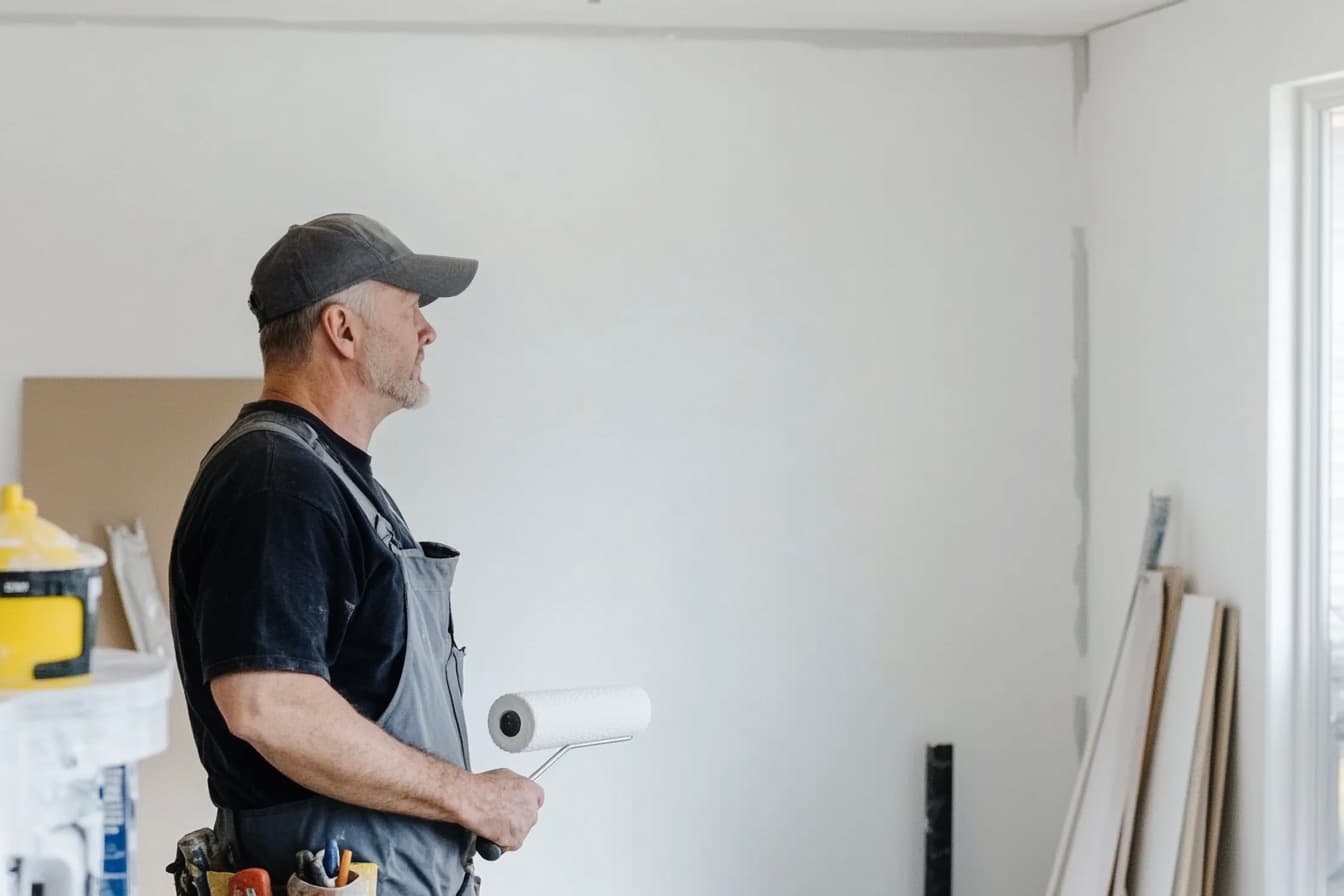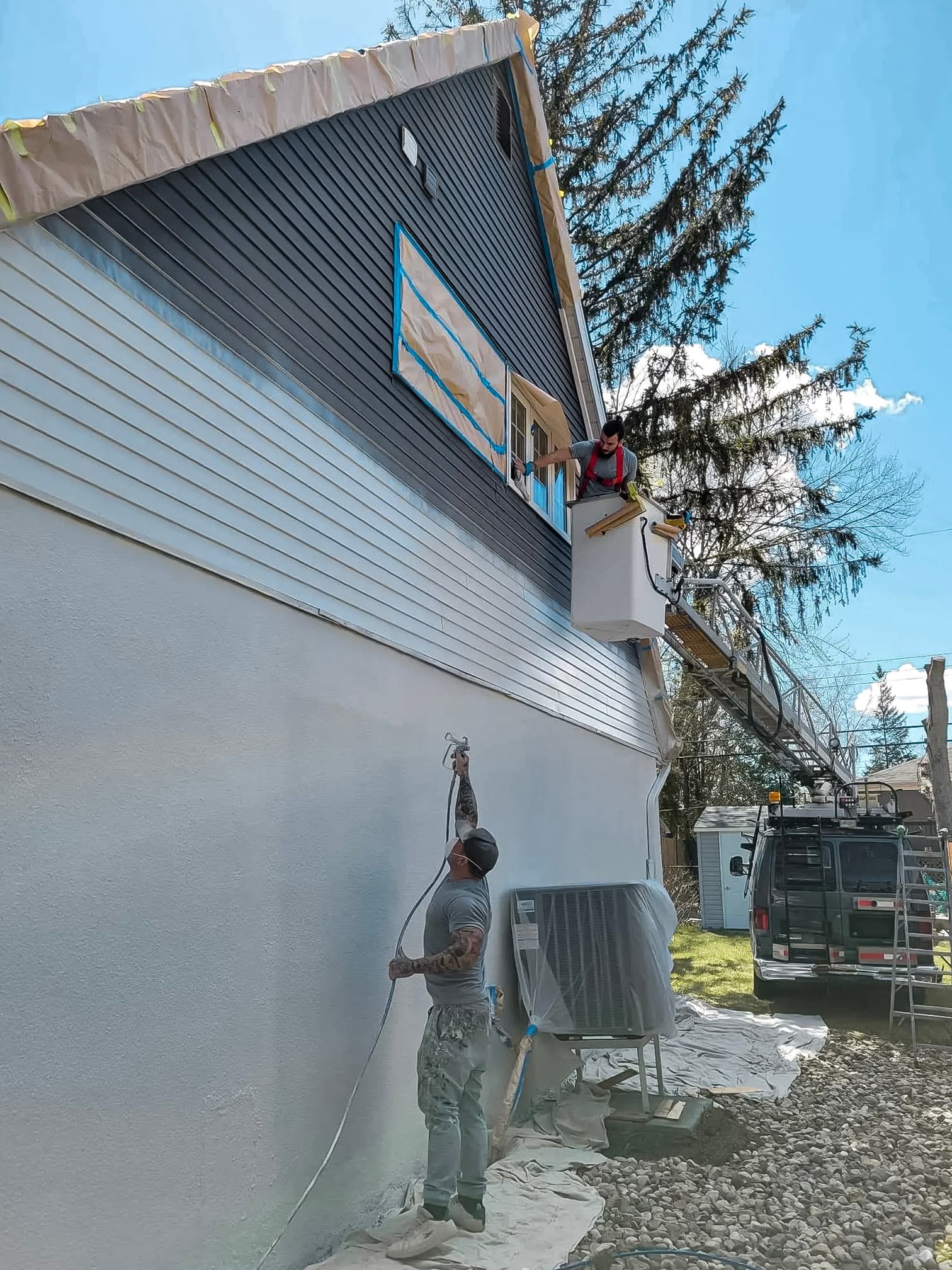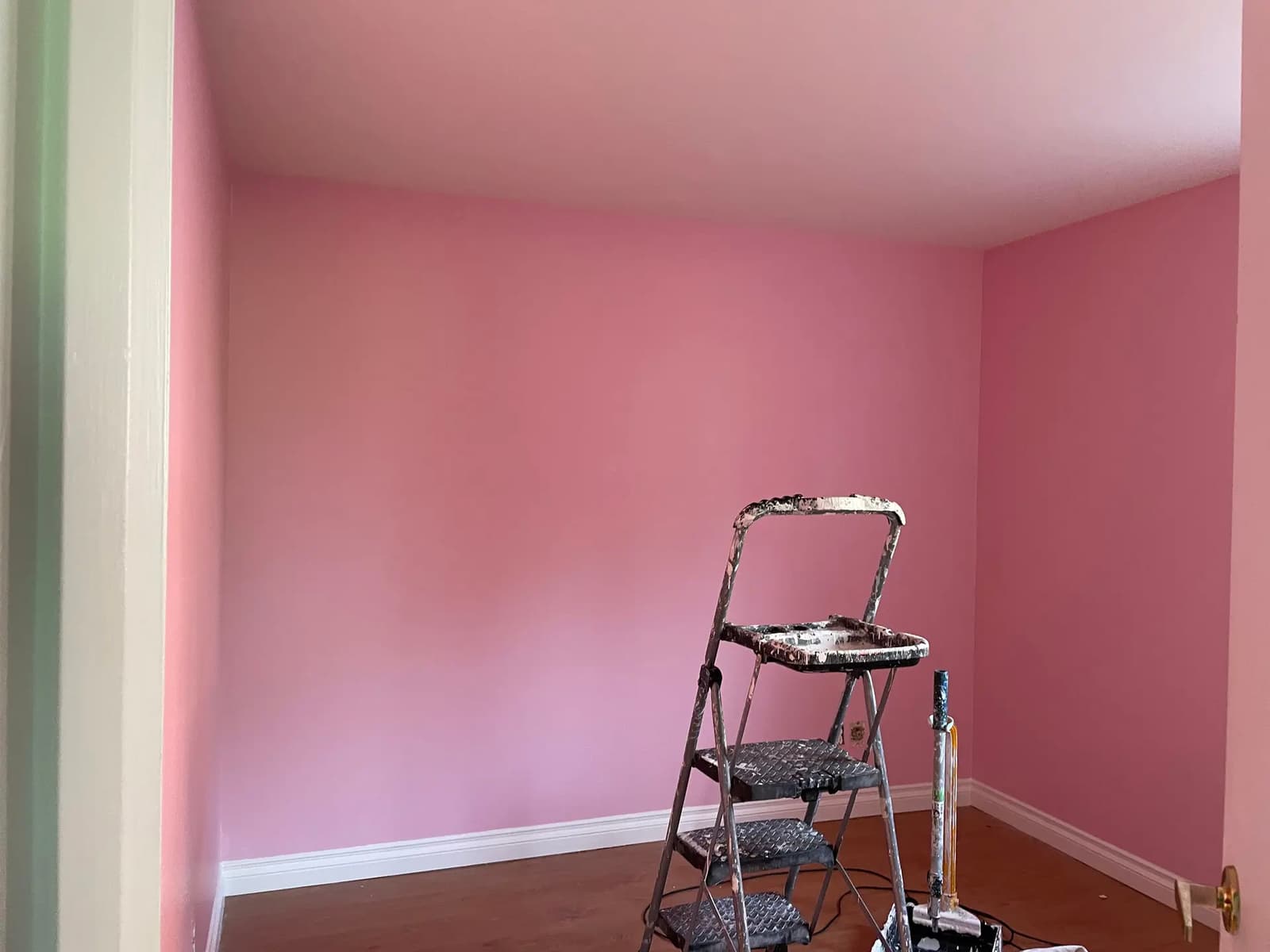Paint Job - Guide and Checklist for Project Success
By Léa Plourde-Archer
Updated on December 5, 2025

Painting your exterior siding or a room in your home is a quick, affordable, and sure-fire way to revamp a dull-looking space. Most people have used a paintbrush or a roller or two in their lifetime, but did you know that meticulous preparation and tailored methods make all the difference between a sloppy paint job and flawless results?
Get Your Project Started Today
Submit your details and receive three free quotes from trusted contractors.
How do you get a surface paint-ready? What common mistakes should you avoid? Which paint types work best on a particular surface or in a specific environment?
This article features a complete checklist covering all key aspects and steps to carry out a residential paint job.
Before Painting Your House
Before laying drop cloths and prepping your rollers, start by familiarizing yourself with the key preparation steps. The following paragraphs are basically food for thought, ensuring you make the best decisions and meet your result-based goals.
Residential Paint Job Keywords

Source : Soumission Rénovation
Quality Products, Flawless Results
If you’re hoping for long-lasting results, choose high-quality prep and finish products. Even if you’re on a budget, avoid buying low-quality products. While it might seem more affordable upfront, you’ll soon find yourself having to touch up recently painted surfaces, yet doing so isn’t as likely if you opted for quality products. Hence, it’s worth tracking sales and looking out for discounts on reliable paint and other products.
Room-Specific Colours and Finishes
Do you already have a few colours in mind, but have you considered whether these shades work in the intended rooms? For instance, if you or a relative is highly sensitive to their environment, it might be best to avoid overly stimulating colours, especially in areas like bedrooms.
Even if you’re set on a red or orange bedroom, said colour combination might be best kept for another part of your house so you’re not disappointed.
As for finishes, it’s purely a question of aesthetics, with a bit of maintenance in between. Some finishes are recommended over others based on the space in question and the surfaces to be painted: a matte finish for ceilings, a gloss finish for moisture-prone areas, and a semi-gloss finish for other rooms.
For more information, check out this article: 3 Things to Know About Colour Psychology.
Low Maintenance
Last but not least, it's important that the walls and other painted surfaces are easy to clean. This is especially true in rooms where the walls are prone to spatter and stains, such as the mudroom, kitchen, and bathroom.
How to Assess Your Needs
Still at the beginning stages of your project, meaning deciding on what areas you want to paint? Before jumpstarting anything, ask yourself key questions to better plan the following steps.
First, outline your goals. Here are a few examples:
Brighten a room
Repair and refresh surfaces (staircase, cupboards, walls, furniture)
Add colour
Change the aesthetic
Frame a specific area in your house
Questions to Ask Yourself When Planning a Paint Job

Source : Soumission Rénovation
What do I want to paint?
It might seem like a silly question, but before meeting painting service contractors, make a list of what you want painted. This way, you’ll be well prepared when it comes to presenting your project and getting more accurate quotes from potential contractors.
When is the right time to take on the project?
For exterior paint jobs, the answer isn’t too far-fetched: Projects must be completed between late spring and mid-fall (barring weather conditions). Otherwise, it won't be feasible. However, for interior paint jobs, timing is a lot more flexible—you can paint inside mid-winter if you wish.
However, some interior paint jobs are a little more tricky to undertake mid-winter, especially since windows can’t be opened to air out freshly painted rooms. That being said, professional painters have enough field-related experience under their belts to work year-round. And if they think waiting until summer is more appropriate, they will advise you accordingly and pencil you for later on in their calendar.
Should I hire out or attempt a DIY approach?
Most people have painted a wall or something at least once in their lifetime. It’s typically one of the first DIY projects homeowners attempt instead of commissioning a residential painting service. It’s a relatively easy job, especially if you’re not too worried about the end result!
However, there are a slew of reasons why it might be best to hire the services of a painting contractor for this type of project. Here are just a few:
They have more experience, therefore work faster and more efficiently.
The results are likely to be a lot more appealing.
They’re familiar with products and can make a better selection.
Furthermore, experienced residential painters are a lot more efficient and fast compared to your typical weekend hobbyist. If you choose a DIY approach, your time is your sole gamble. Maybe said time could be put toward more rewarding activities or hobbies. Moreover, financially speaking, it might not even be that cost-effective to do it yourself. Think about it!
Want to learn more about painting contractors and their role, including the upsides of hiring out such services? Check out our article:
Should I be the one buying tools and products?
Some contractors would rather buy the necessary tools and products themselves, while others are used to working in tandem with customers. Ask the hired painters about your options during the initial stages, of the quoting phase. However, note that buying through the hired contractor might be quite cost-effective, given that industry professionals often have retailer-specific deals and access to discounted retail prices.
Am I staying put or relocating for a few days/weeks?

Source : Thomas Construction Services
It depends on the scope of the work—you may have to relocate for a few days to ensure the jobsite is easier to navigate for both the contractor and their team. Having you out of the way while they’re working will streamline the process, that’s for sure.
However, relocating isn’t always a possibility, especially if the project in question is centred around a single room (or surface) or if the project isn’t supposed to take more than a few days. Together with the contractor, assess whether you should relocate fo the duration of the project or stay on-site.
Budget: How Much Does It Cost to Paint One Room, and How Much Does It Cost to Hire a Professional Service?
Paint jobs are typically considered one of the most affordable home improvement projects while still highly effective in revamping a home. The overall project cost hinges on several factors, including:
Condition of the work area (Are repairs needed?)
Number of walls and other areas to paint
Number of coats required
Labour costs (number of workers, time involved)
Type of product or paint used
Job complexity (angles, skirting boards, trims, multiple colours)
Bear in mind that the quality of the paint and its application will directly impact result longevity. Oftentimes, it’s more cost-effective in the long run to invest in quality products and a professional paint job.
To get a better sense of the costs involved, check out these two paint job-related articles:
Try our cost estimator for a project-specific ballpark figure.
Do I need to request a permit?
Note that the information below is valid for most cities.
Some exterior paint jobs don’t require a permit—painting a balcony, stoop, porch, deck, or stairs. However, make sure there aren’t any colour-related city regulations or restrictions.
If you want to repaint prominent areas, such as your siding or roofing, contact city authorities to know whether a permit is required or not.
As for interior paint jobs, typically speaking, they don’t require a permit acquisition.
Can a painting project affect my day-to-day life?
In general, this sort of project is considered a short-lived home improvement. However, if you choose to repaint your whole house, it may take a few days, weeks even. Moreover, paint can be bothersome to some dwellers, not only on account of its fumes and smells, but because it takes a long time to dry.
For large-scale paint jobs, it may be advisable to relocate for the duration or limit your living spaces to avoid those being repainted.
Residential Paint Renovations

Source : Construction TRC
How to Prep and Prime a Surface for Paint
When heading the DIY route, all too often, the surface prep step tends to go out the door. Damaged sections must be repaired and sanded to relevel the surface, and then possibly covered with at least one coat of primer.
This step is very important in the long run as it will make results more resilient and visually appealing. If you hire painting experts, they will ensure the surfaces to be painted are adequately prepped.
Check out the articles linked below to uncover the different prep methods used for paint jobs.
Most paint jobs concern repainting interior walls. However, paint can also be used to cover other types of surfaces, including metal, wrought iron, ceramic, or wood.
The articles listed below provide valuable information on preparing for a paint job:
The Different Paint Products Retailed
Products | Characteristics |
Interior acrylic paint | Water-based, practically odourless, easy to clean, quick-dry, ideal for interior walls. |
Latex paint | Long-lasting, ideal for high-traffic areas like hallways and children’s bedrooms. |
Alkyd paint | Oil-based, for a smooth and long-lasting finish, ideal for woodwork and moulding. |
Universal primer | Preps surfaces for increased paint adherence. |
Water-based stain | Easy to apply, quick-dry, for interior and exterior use. |
Oil-based stain | Seeps deep within the wood grain, excellent weatherproofing. |
If you’re far from a novice when it comes to paint jobs, then you’re likely familiar with the broad range of products marketed:
First, pick out your colour(s).
Next, consider the desired finish: Eggshell, pearl, semi-gloss, high gloss, matte, ultra-matte.
There are also a lot of surface-specific products (kitchens and bathrooms, metal, wood, exterior surfaces, etc.).
If you choose to purchase paint products yourself, make sure to get an expert’s take. List the intended work, share pictures of said surfaces, and follow their advice. You can also hire a contractor, ensuring you’re on the same wavelength when it comes to colours and textures.
To help steer you in the right direction, check out these two articles:
How to Repaint the Inside and Outside of a House - A Step-by-Step Guide

Source : Groupe Action Peinture inc.
Here’s an overview of what a paint job entails:
Prep the jobsite: Cover furniture and areas not being painted
Tape off any necessary edges
Repair damaged areas
Apply a primer
Apply paint (wait allotted time between coats)
When finished, thoroughly clean the tools
Make sure unpainted surfaces aren’t splattered with paint
For an exterior paint job, consider the weather forecast on the day of and the days following. If rain is forecasted for the next 48–72 hours post-paint job, wait for sunnier days. If you overlook this guideline, the paint won’t adhere as intended to the painted surfaces.
Check out our article: What Are the Ideal Conditions to Paint Outside?
More useful information to get organized:
We gathered a few articles to help you make informed decisions throughout your painting project:
Residential Paint Job Toolbox
Painter’s tape (and other edge-cutting tools, such as paint edger pads)
Quality paintbrushes and rollers
Paint extension pole (for rollers)
Paint bucket
Paint roller tray
Coveralls
Floor and furniture tarps
Potential Problems
Even if paint jobs are relatively “easy” and typically done without a hitch in most cases, problematic situations may arise. Check out the most common mistakes to avoid during a painting project to ensure flawless and long-lasting results.
Moreover, a paint job might be called for in the event that a surface exhibits a problem that needs fixing. For instance, if you notice that the paint in your bathroom or basement is chipping or flaking, applying a new coat of paint over the flaking one won’t fix the issue at hand.
Hire a Contractor
For a paint job, hire either a commercial or residential painter or a general contractor.
Here’s a list of criteria to consider no matter the hired professional:
Experience: How much field experience do they have?
References: Request work references and reach out to former customers to vet the quality of their work.
Insurance: Make sure the contractor has valid liability insurance.
Quote comparison: Carefully compare project costs, services provided, and work guarantees offered.
Project Handover

Source : Construction TRC
What Should You Look Over?
Colour uniformity and finish: Make sure the colour is applied evenly and the finish meets your expectations.
No paint drips or paintbrush/roller streaks: Make sure the edges are clean and surfaces adequately coated.
Clean cuts: Edges and angles must be well-defined.
Unpainted surfaces were properly protected: Make sure all flooring, furniture, and equipment were properly shielded.
Compare the Work Done with the Quote Provided
Check whether all intended surfaces were painted: Make sure all walls, ceilings, and other surfaces were worked on as agreed.
Make sure all colours and finishes are up to par: Compare the results against samples or initial specifications.
Test Equipment
If you had doors or window frames painted, make sure they can be easily opened and shut, ensuring they weren’t damaged in the process.
Looking for something else?
Related articles
The latest industry news, interviews, technologies, and resources.

Editorial Team
•03 Nov 2025
Whether it’s on a floor, wall, or directly on to-be-installed ceramic tiles, painting ceramic tiles is a relatively simple task. This process can be summed up in three steps: clean, sand, and paint.

Cynthia Pigeon
•07 Nov 2023
While painting a wall may seem like a rather simple thing to do, it is nonetheless easy to overlook a few basic rules and end up with a botched final outcome. In order to avoid this, here is a list of common mistakes to avoid when painting.

Cynthia Pigeon
•08 Oct 2025
Are you looking for a rewarding and worthwhile job? Looking to start a new career and are still debating as to which trade would suit you best? Why not opt for electrical power line installation? Do you know less than nothing about the trade but are still jumping in with both feet? Well, check out this article to learn more about it!

Léa Plourde-Archer
•07 Nov 2023
Installing a hardwood floor can have a huge impact on your house: it can transform a room and increase the value of the building. Timeless and durable, hardwood floors are also popular because they are known for their warmth and beauty.

Amanda Harvey
•12 Dec 2023
Walking through the front door of your home should always be exciting. It’s true that after a long day of work or running around, we all hope for a space that’s organized and comfortable.